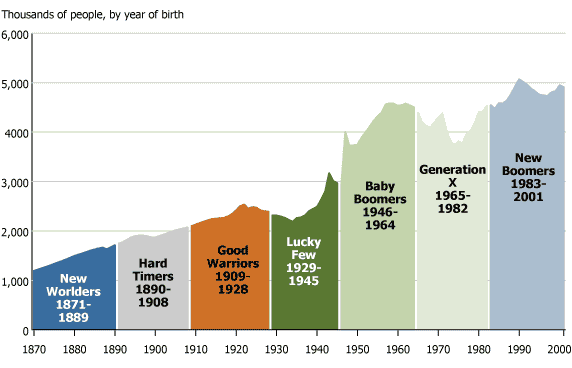Eric Zuehlke
Former Web Communications Manager

September 18, 2008
Former Web Communications Manager
(September 2008) Each generation has unique characteristics, and a generation’s size and relationship to a previous generation can shape lifelong social and economic opportunities. The often-overlooked generation of the “Lucky Few”, those born from 1929 through 1945 after the Greatest Generation but before the first baby boomers, exemplifies these connections. Elwood Carlson, Florida State University professor in sociology of population, has researched the Lucky Few, and has documented his findings in his book The Lucky Few: Between the Greatest Generation and the Baby Boom. On Sept. 10, he spoke at PRB’s monthly policy seminar.
Carlson’s research was largely inspired by Richard Easterlin’s Birth and Fortune: the Impact of Numbers on Personal Welfare. The role of generation has direct and indirect effects on each individual. The size of one’s generation has a direct impact on employment and social opportunities. But the experience of previous generations affects the social and economic context in which each individual is raised. This lingering indirect effect of previous generations has just as much impact. For the Lucky Few, a confluence of historical forces has created a fortuitous path.
The Lucky Few include Martin Luther King Jr., Elvis Presley, Sandra Day O’Connor, and John McCain. So why has this generation largely been overlooked? “One of the reasons is because they’re the first generation in American history that is smaller than the generation before them,” said Carlson. “If you’re thinking about advertising markets, audience for your programs, customers in your stores, and so on, there are many more baby boomers.” Indeed, there are 78 million baby boomers but only 41 million in the Lucky Few.
U.S. Generations at Age 30 (with projections for births after 1978)  Source: U.S. Census Bureau.
Source: U.S. Census Bureau.
This generation has been lucky for various reasons. They were born during the upheaval of the Great Depression and World War II but enjoyed a smooth and easy transition to adulthood in the relatively prosperous 1950s and early 1960s. Men served in the military as much as those in the Greatest Generation but their time in uniform was not marked by war and high casualties to the extent of the previous generation. The Lucky Few enjoyed higher employment rates than preceding and following generations. Now between ages 63 and 79, this generation is enjoying better health and retiring earlier.
African Americans in this generation also fared better than preceding generations in education and employment, with rates that came closer to whites. But blacks in the Lucky Few did not make as much progress as blacks in the baby boom.
Carlson noted that the experience of women across generations differs greatly, but he also believes that this experience is largely a matter of perspective. He pointed out that women in Generation X (born between 1965 and 1982) have benefited from much higher rates of employment than women in the Lucky Few. For instance, 69 percent of 29-year-old women in Generation X are employed, as opposed to about 41 percent of women in the Lucky Few when they were 29. “If we look at the situation today, a lot of women would not say that women in the Lucky Few were lucky. But if you talk to women in the Lucky Few and ask if they were lucky, they would say ‘You bet I was lucky!’ ”
The Integrated Public Use Microdata Series (IPUMS) proved essential for Carlson’s research. He used samples from every census from 1880 through 2000 along with every annual Current Population Survey from 1962 through 2007 and a number of other survey data sets. Carlson looked at waves in births and migration, and consequent waves in marriage timing and the makeup of the labor force.
The lessons of examining the unique characteristics of the Lucky Few extend far beyond understanding just one generation. According to Carlson, “If you understand the difference between generations, it helps you understand yourself better because you understand the context in which your life has unfolded. You understand what distinctive opportunities and problems you have faced and you can find common ground with others in your generation.” Everyone has parents, grandparents, bosses, and employees of other generations they’re trying to understand, Carlson explains. “If you approach them in the same framework as you try to approach your own world, you’re going to be making mistakes. If you want to understand them, you have to understand their generation as well as your own.”
Eric Zuehlke is an editor at the Population Reference Bureau.
For More Information
Elwood Carlson, The Lucky Few: Between the Greatest Generation and the Baby Boom (New York: Springer, 2008).
